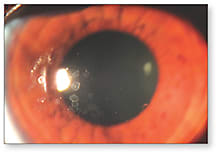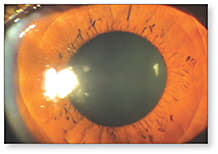Patients who have suboptimal lens wetting can experience blurry and/or fluctuating vision, decreased wearing time, and discomfort. Slit lamp exam will reveal dry spots and distinct non-wetting areas, ranging from mild to severe. Because discomfort is the number one reason why contact lens wearers drop out, anything we can do to maximize comfort and wettability is worth it.
Lens Care
Preparation and Hygiene Are your patients using oil-based lotions or soaps prior to applying lenses? Are they applying makeup before or after lens application? Is their makeup or makeup remover contributing to excess lipids or oils on the ocular surface?
Type of Care System Ask patients what contact lens care system they are using. Do they remove their contact lenses every night? Do they rub their lenses before soaking them? How long do the lenses disinfect? I often switch multipurpose solution users to a hydrogen peroxide system to see whether their symptoms improve.
Lid and Ocular Health
Carefully examine eye lids and lashes. Is there meibomian gland dysfunction or dropout? How is their tear breakup time? Do the lids look scalloped? A healthy ocular surface is critical to maintaining a wettable surface for any contact lens, so evaluation and management early on can help improve success. Treatment options include lid scrubs, in-office deep cleaning of lids and lashes, meibomian gland heating/expression, omega-3 fatty acids, eye drops, gels, and more.
Material Options
My next step is to change contact lens materials. Talk to your lab consultants about what GP lens design options might be best for patients’ needs. Some GP materials have better wetting properties compared to others. Lenses made with silicone allow more oxygen, but at the cost of decreased wettability and greater protein deposits.
Lens Coating Technology
A new technology called Hydra-PEG (Tangible Science) is a 90% water polyethylene glycol (PEG)-based polymer mixture that is permanently bound to the lens surface. Lenses that are coated with Hydra-PEG have a mucin-like surface, which significantly improves wettability and lubricity, increases surface water retention, and reduces deposits. The coating makes lenses feel slippery, so be sure to tell your patients that this is quite normal. One study showed that lenses treated with Hydra-PEG had improved comfort and wettability and less lens fogging (Walker and Redfern, 2016) (Figures 1 and 2). I have had much success with this new product. To order this surface treatment, simply ask your lab of choice whether they offer it.


This new technology may prove effective for patients who have stubborn wettability problems that are not resolved with any other management strategies. It is exciting that we have a new tool in our toolbox to help more patients remain satisfied with their GP lenses. CLS
For references, please visit www.clspectrum.com/references and click on document #256.





